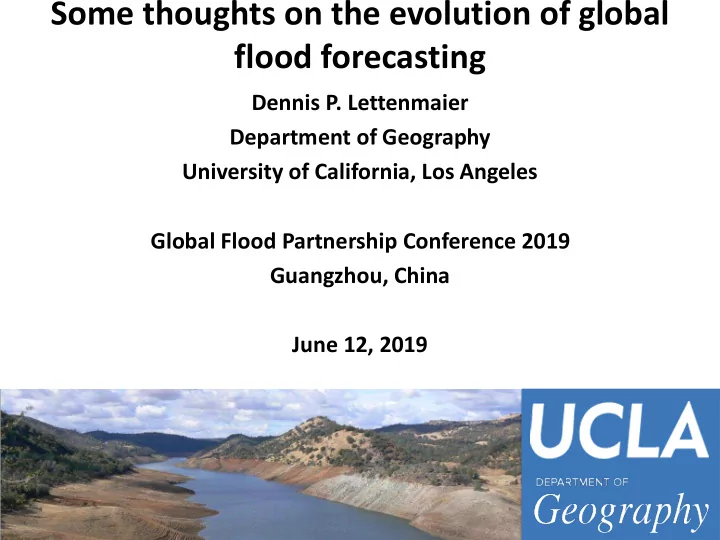

Some thoughts on the evolution of global flood forecasting Dennis P. Lettenmaier Department of Geography University of California, Los Angeles Global Flood Partnership Conference 2019 Guangzhou, China June 12, 2019
Distinction between flood prediction and flood forecasting Forecasting is for a particular (lead) time, whereas prediction is not. Hence, we forecast the river stage at noon on say June 12, but we predict the 100-year flood. So ECMWF is ECMWF rather than ECMWP (but then, what about NCEP?) In any event, this talk focuses on forecasting
Outline 1) Flood forecast protocols in the developed world (focus on U.S.) 2) Special challenges in the developing world (where GFP is most needed) 3) Where are the gaps, and how can they be closed?
Flood forecast protocols in the developed world
Three lead times for flood forecasting T1: precipitation forecast lead time T2: time for precipitation incident on a watershed to reach the channel system T3: time for water to move through the channel system to the forecast point for flood forecast lead time τ: Τ < T 3 need channel routing only PATH 1 T 3 < Τ < T 2 + T 3 need hydrologic forecast and channel routing PATH 2 Τ > T 1 + T 2 + T 3 need channel routing, hydrologic forecast, and precipitation forecast PATH 3
Forecast assets in the U.S. (arguably typical of developed countries) 1) Stream gauge network (USGS operates ~8000-9000 gauges, 80-90% in real time, of these ~3500 are NWS real-time forecast points (provide both discharge and stage) 2) Precipitation observations – most of CONUS “flatlands” have precipitation radar coverage, plus several thousand precipitation gauges report in real-time 3) Detailed flood plain topographic data (Lidar in many cases) 4) Precipitation forecasts (from global and regional models) 5) Calibrated flood forecast model(s) using historical data from 1) and 2) that predict discharge at (upstream) forecast points 6) Calibrated channel routing algorithm(s) that predict discharge at downstream forecast points (and perhaps river stage) given discharge at upstream points
Chehalis River basin, Washington with USGS real-time stream discharge stations
Processing Deterministic Streamflow Prediction Daily RFC Operations • Data Ingest • Data QC + Processing • Model Updating Forecast Mean Areal CHPS Time Series HAS Unit Hydrologic Operations Models Precipitation Temperature Freezing Level Current Conditions • Soil Moisture • Snow water • Reservoir Levels • Streamflow
Flood forecast example, Russian River (CA) near Guerneville, December 2005. Blue: observed discharge, green: forecast discharge 8 AM Dec 26
The approach is highly dependent on a) real- time streamflow data, and b) high quality (in situ or radar) model forcings, especially precipitation (note that NSW uses mean areal (not spatially distributed) precipitation
Special challenges in the developing world (where GFP is most needed)
• Little or no stream gauge data (esp. real-time) • Precipitation data limited to (generally lower quality) satellite or NWP analysis fields* (other forcing variables can come from NWP) *not clear which is preferred
What hydrologic data do we have? • Mostly inundation extent (and low quality DEM from which depths might be derived) • Some altimetry (very large rivers) – mostly retrospective
Red: Flooding, Northern during a 10-day Thailand accumulation of MODIS imaging. flooding, Fall, 2011 Light Red: Previously flooded, now dry. Blue: Reference Water (permanent water bodies). Visuals courtesy Dartmouth Flood Observatory
Where are the gaps, and how can they be closed?
Near-term opportunities • More surface extent data (lots of satellites, accessibility in near real-time issues, and mostly visible, hence cloud cover issues • Combine inundation extent with higher quality DEMs to get inundation depth (both real-time and retrospective opportunities) • Faster processing of SAR data (avoids cloud cover issues • More attention to “Path 1” forecasts (needs retrospective analysis)
Longer term opportunities: SWOT (Surface Water and Ocean Topography Mission, planned launch 2021) and NISAR (also 2021) will give us: • Channel cross-section estimates (via combination of multiple overpasses ) down to low water (assume geometry, e.g., parabolic below that level) • Inundation extent (snapshots) and water surface topography (including slope) • Mostly retrospective (overpass ~10.5 days) except opportunistically • But – could use SWOT archive to develop relationships between near-real time surface extent imagery (other sources) and water surface depths to improve hydrodynamic models
Summary 1) Global flood forecasting is a compelling problem, and work over the last ~10 years has shown that it’s feasible with current observational and modeling assets 2) The challenge now is to go from maps of inundation (“hit/miss”) to quantitative predictions of flood depths, durations, and timing 3) Better and more creative exploitation of existing assets (both modeling and observational) in addition to new observations (mostly remote sensing) should lead to progress.
Recommend
More recommend